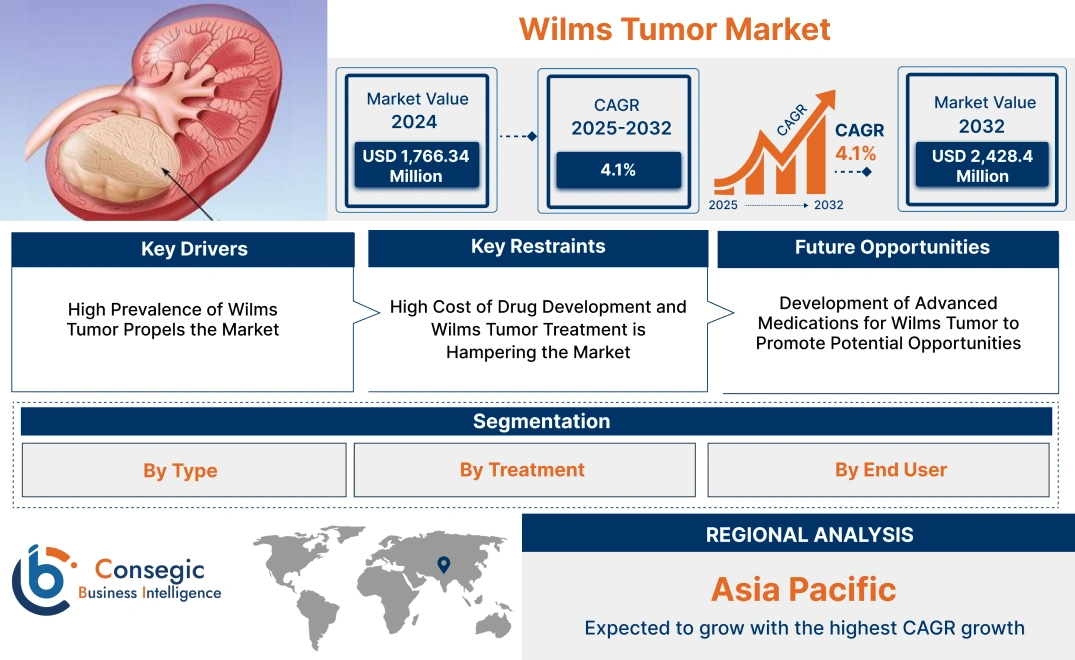Wilms Tumor Market Size:
Wilms Tumor Market size is estimated to reach over USD 2,428.40 Million by 2032 from a value of USD 1,766.34 Million in 2024 and is projected to grow by USD 1,806.58 Million in 2025, growing at a CAGR of 4.10% from 2025 to 2032.
Wilms Tumor Market Scope & Overview:
Wilms tumor, also referred to as nephroblastoma, is a common renal cancer in the pediatric age group. It is a rare kidney cancer that mainly affects children. It most often affects children ages 3 to 4. It becomes much less common after age 5, but it can affect older children and even adults. It mostly occurs in just one kidney. But it can sometimes be in both kidneys at the same time. Based on the severity of the disease, it is categorized into five stages. The combination of symptoms includes mass in the stomach area, swelling and pain in the stomach area, and blood in the urine. Based on observation of the tumor histological section, the Wilms tumor is divided into two types: favorable histology and anaplastic histology. The treatment of this pediatric cancer typically involves chemotherapy, targeted therapy, surgery, and radiation therapy.
Wilms Tumor Market Dynamics - (DRO) :
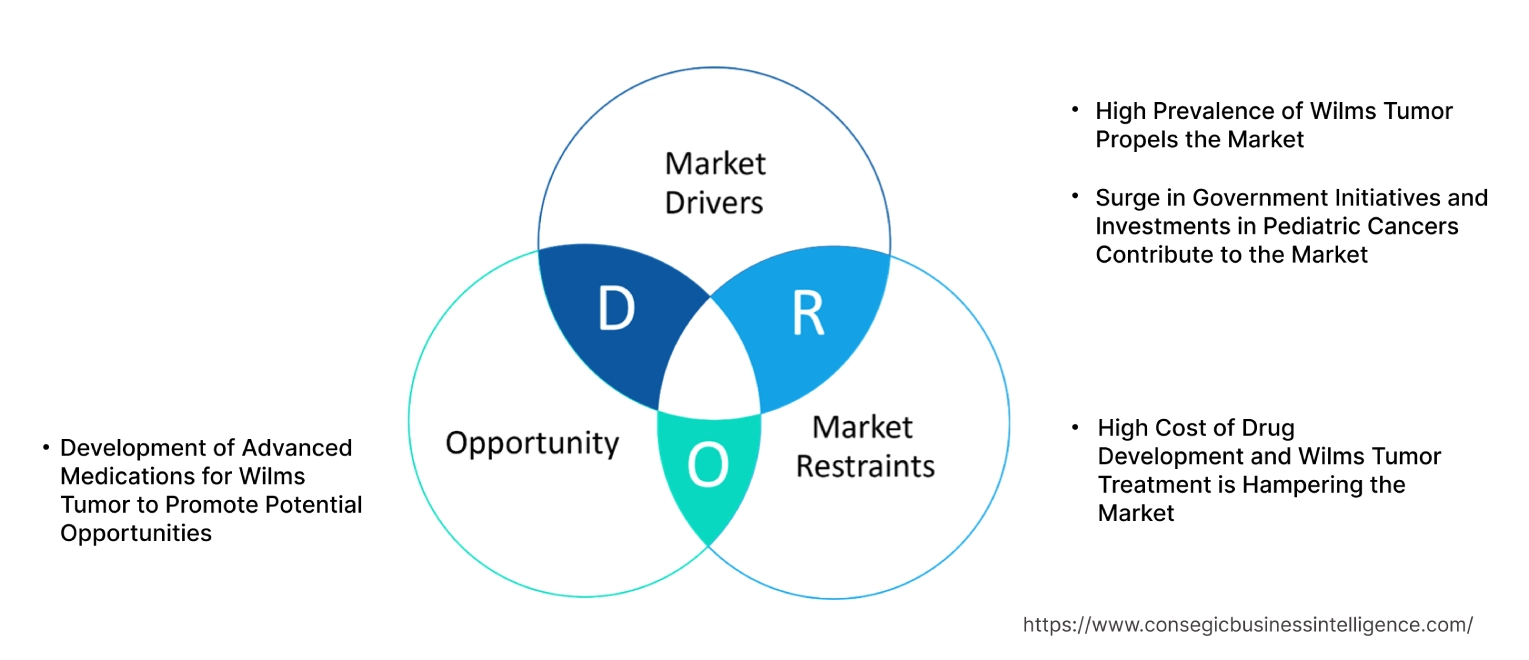
Key Drivers:
High Prevalence of Wilms Tumor Propels the Market
Wilms tumor is a renal cancer occurring in the pediatric age group. This cancer is a malignancy that originates when the kidney cells start to grow uncontrollably. The tumor is typically associated with several syndromic, non-syndromic, and genetic factors that lead to renal anomalies.
- According to the review article published by the Nature Journal on October 14, 2021, Every year approximately 14,000 children 0–14 years of age are diagnosed worldwide with malignant renal tumors, and 5,000 children die from these diseases. Moreover, as per this article, the annual incidence of Wilms tumor is the highest in the USA with an incidence of 9.7 per million among children with African-American ancestry.
Thus, as per the market trends analysis, the growing incidences of Wilms tumor is driving the market worldwide.
Surge in Government Initiatives and Investments in Pediatric Cancers Contribute to the Market
Rising efforts by the government for cancers in children assist as a potential factor driving the market globally. The consistent efforts taken by the government to promote the better management of childhood cancer are creating a significant boost in the market. Additionally, there is also an increase in funding and grants by government and private institutions for innovative solutions.
- In February 2022, the Cancer Prevention and Research Institute of Texas announced 7 grants for a total of USD 9.7 million to advance the prevention, detection, or treatment of childhood and adolescent cancer. Moreover, according to the data published by the Government of Canada in January 2023, the Canadian government announced an investment of USD 23 million for pediatric cancer research in budget 2021.
Overall, the market analysis shows that commendable initiatives taken by government bodies are propelling the Wilms Tumor market growth.
Key Restraints :
High Cost of Drug Development and Wilms Tumor Treatment is Hampering the Market
The high cost of drug development and treatment for Wilms tumor is a substantial factor, and the cost of any treatment continues to upsurge confining the growth of the market. Multiple factors contribute to the high cost of drug development and treatment such as research, clinical trials, approval, and commercialization. Additionally, before any drug reaches the market, it must undergo various research and clinical trials before public launches. This process is time-consuming and often requires a large amount of investment.
- For instance, according to data published by the Congressional Budget Office (CBO) in April 2021, estimates of the average R&D cost per new drug range from less than USD 1 billion to more than USD 2 billion per drug. Especially, for novel drugs this cost surges. Moreover, severe and advanced stages of Wilms tumor require surgical treatment which is often complicated and requires experienced personnel and specialized medical facilities which further raises the cost of treatment.
Thus, the analysis of market trends depicts that the above-mentioned reasons are restraining the Wilms Tumor market demand.
Future Opportunities :
Development of Advanced Medications for Wilms Tumor to Promote Potential Opportunities
The demand for advanced solutions for childhood cancers has motivated the increase in investment in research and development activities. There is also an increase in research performed by leading biopharmaceutical companies for innovative solutions such as novel medications to existing chemotherapy drugs to manage the Wilms tumor among pediatric patients.
- In May 2022, Cue Biopharma, Inc., a clinical-stage biopharmaceutical company announced that the U.S. Food and Drug Administration (FDA) has accepted the Company's Investigational New Drug (IND) application for the evaluation of CUE-102, its second interleukin 2 (IL-2)-based CUE-100 series biologic, in a dose escalation and expansion monotherapy Phase 1 trial, which will have a starting dose of 1 mg/kg for the treatment of Wilms' Tumor 1 (WT1)-positive recurrent/metastatic cancers. WT1 is a tumor suppressor gene associated with the development of Wilms' Tumor. This acceptance of the new drug application is expected to promote the development of a successful new biologic product for the management of Wilms tumor and its comorbidities.
Consequently, consistent demand to come up with innovative efforts is expected to create enormous Wilms Tumor market opportunities.
Wilms Tumor Market Segmental Analysis :
By Type:
Based on type the market is categorized into favorable histology and anaplastic histology.
In 2024, the favorable histology segment accounted for the largest market share and it is also expected to hold the fastest CAGR over the forecast period.
- Histology is the microscopic structure of the tissue sections. Based on how Wilms tumor cells are observed under the microscope, favorable histology is characterized by the presence of a triphasic pattern of blastema, epithelial, and stromal tissues.
- This type of tumor possesses a better prognosis, and survival rate, and positively affects the treatment decisions.
- The high occurrence rate of this type of tumor is the potential factor driving the segment.
- According to the research study published on the NCBI on March 2, 2023, among the 41 children involved in the study, 31 of the children diagnosed with Wilms tumor had favorable histology, which accounts for 75.6% of cases.
- Thus, the segmental trends analysis shows that the large prevalence rate is a significant factor that is fuelling the Wilms Tumor market demand across the globe.
By Treatment:
The treatment segment is categorized into chemotherapy, radiation therapy, surgery, and targeted therapy.
The surgery segment accounted for the largest revenue of the total Wilms Tumor market share in 2024.
- Wilms tumor is typically treated through surgical procedures. The first-line treatment option for this type of tumor is nephrectomy, which involves removing all tumoral renal tissue while preserving as much functioning kidney as possible.
- Depending on the stage of the tumor, surgery may be performed individually or in combination with other treatment solutions, such as chemotherapy and radiation therapy.
- The prompt removal of the tumor and the reduction of treatment time are potential factors driving the segment. In addition, technological advancements such as minimally invasive surgery have contributed to the Wilms Tumor market growth.
The targeted therapy segment is anticipated to register the fastest CAGR during the forecast period.
- Targeted therapy uses drugs to identify and attack the molecules and pathways specifically involved in tumor formation.
- Several types of targeted therapies for cancers, such as gene expression modulators, hormone therapies, apoptosis inducers, angiogenesis inhibitors, and signal transduction inhibitors are expected to take a stake in the targeted therapy.
- Furthermore, the rising focus of companies on developing novel drugs and therapies for treating Wilms tumor is expected to boost the market over the forecast period.
- In May 2022, the US Food and Drug Administration accepted an investigational new drug application by Cue Biopharma to study CUE-102 as a treatment for patients with Wilms' tumor 1-positive recurrent or metastatic cancers.
- Thus, the aforementioned factors are creating lucrative Wilms Tumor market trends in the coming years.
By End-User:
The end-user segment is categorized into hospitals, research and development centers, cancer centers, and others.
The hospital segment accounted for the largest revenue share of 38.42% of the overall Wilms Tumor market share in 2024.
- Hospitals assist as the primary providers of cancer care.
- They play a major and crucial role in helping patients by providing convenient, affordable, and easy access to tumor treatment.
- In addition to this, hospitals also offer the distribution of medications to their patients which is a key factor driving the segment.
- Similarly, hospitals are equipped with state-of-the-art healthcare infrastructure, advanced treatment facilities, and medical personnel required for the better management of tumors.
- Consequently, the segmental trends show that as the prevalence of Wilms tumor is continuously growing, the crucial role played by hospitals for its treatment and the significant rise in the hospital industry are driving the Wilms Tumor market trends.
The cancer centers segment is anticipated to register the fastest CAGR during the forecast period.
- Cancer centers are dedicated facilities that are typically involved in cancer research and provide services including cutting-edge care, clinical trials and support directly to cancer patients.
- The growing investments in the development of cancer centers are the significant factor expected to propel the segment's growth.
- In December 2022, the University of Kansas Cancer Center was awarded USD 43 million through the federal spending bill. The allocation is expected to help the cancer center plan and build a 670,000-square-foot research facility.
- Thus, the analysis of segmental trends depicts that the significant rise in cancer center expenditure is expected to create enormous Wilms Tumor market opportunities for the segment.
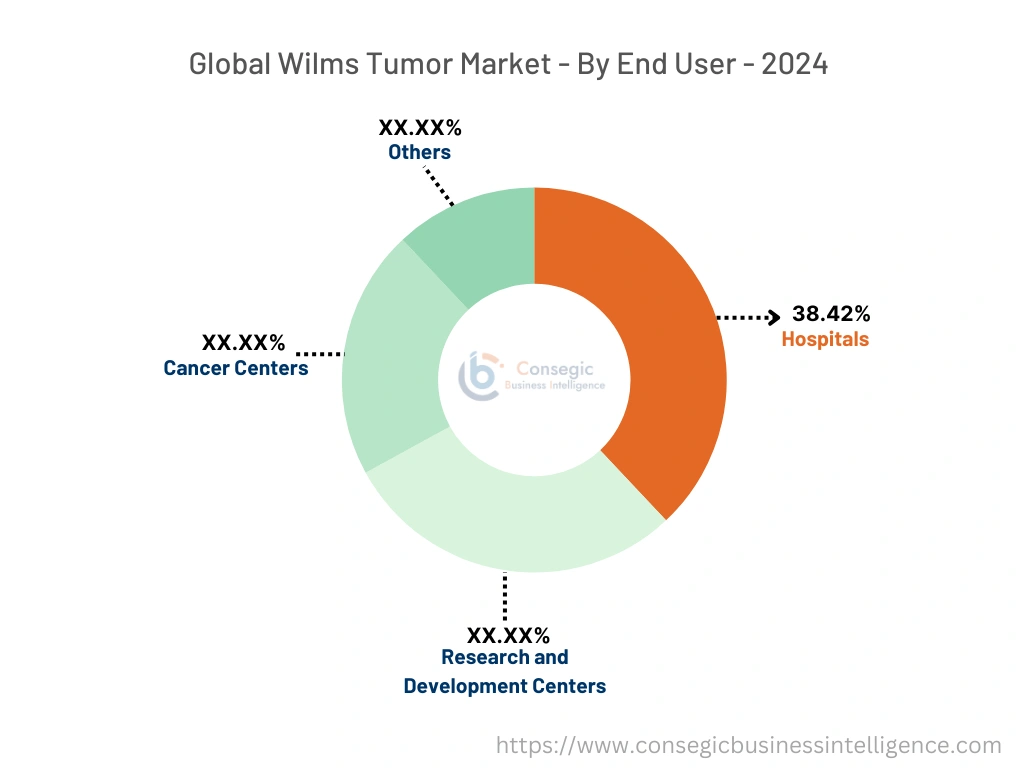
Regional Analysis:
The regional segment includes North America, Europe, Asia Pacific, the Middle East and Africa, and Latin America.
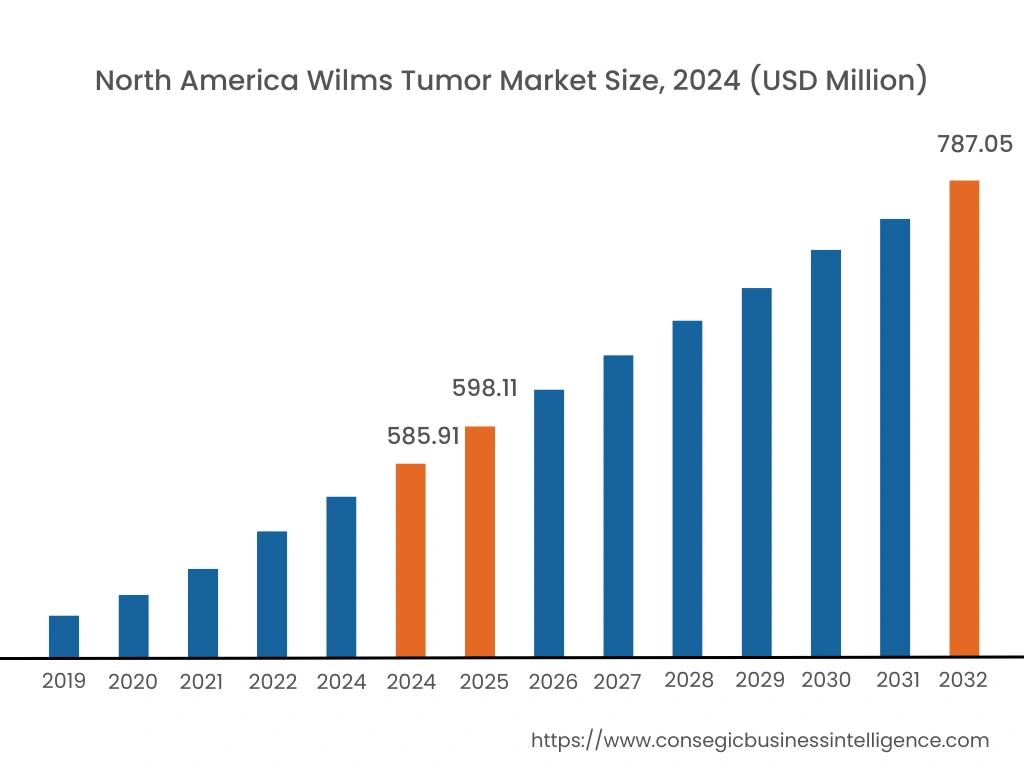
In 2024, North America accounted for the highest market share at 35.44% and was valued at USD 585.91 Million, and is expected to reach USD 787.05 Million in 2032. In North America, the U.S. accounted for the highest market share of 68.75% during the base year of 2024. As per the Wilms Tumor market analysis, the North American region is experiencing a significant rise, owing to the rising incidences of tumors among children, the availability of advanced medical facilities, and the presence of well-established healthcare systems across the region. Additionally, growing government investments in children's cancer are driving the market across the region.
- The Childhood Cancer Data Initiative (CCDI) was launched in 2019 as a USD 50 million per year, 10-year investment to harness and share data in ways that make faster progress in childhood cancers.
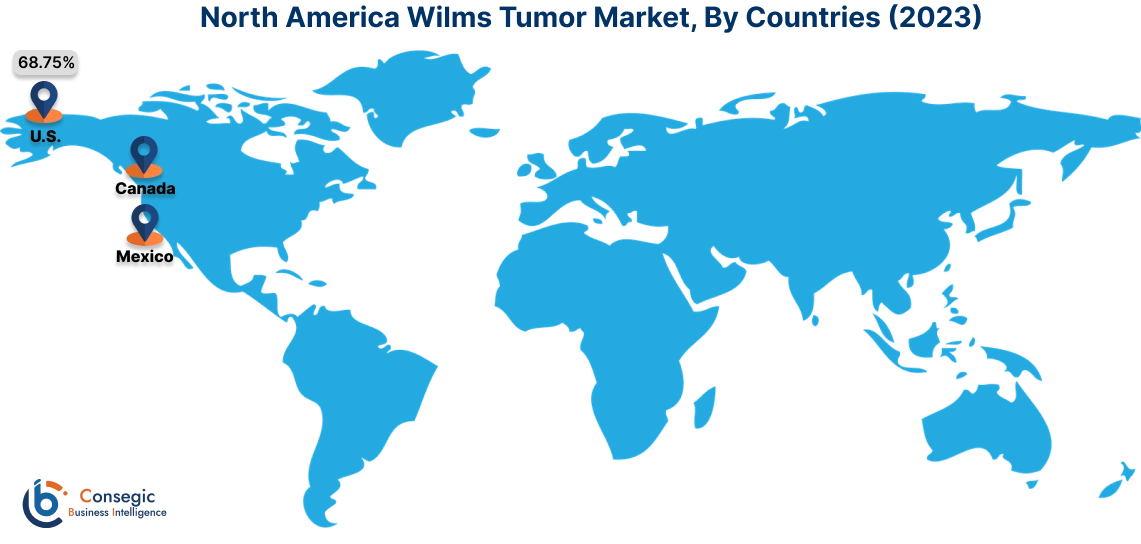
Asia Pacific is expected to witness the fastest CAGR over the forecast period of 4.8% during 2025-2032. The significant growth in healthcare spending, better health awareness, and significant growth in the healthcare and pharmaceutical industry across the region are expected to increase the treatment facilities for tumors across the region. Moreover, the increasing support by the government to provide cancer care facilities is expected to foster market growth.
- According to the article published by the Press Information Bureau on February 10, 2023, the Government of India approved 19 State Cancer Institutes and 20 Tertiary Care Cancer Centres under the Tertiary Cancer Care Centres Facilities Scheme.
The market in Latin America is steadily growing, driven by improved healthcare infrastructure and rising awareness of pediatric cancer. However, limited access to advanced treatments and diagnostic technologies in rural areas hampers broader Wilms Tumor market expansion. The regional market trends in the Middle East & Africa face significant challenges due to underdeveloped healthcare infrastructure and limited access to specialized pediatric oncology care. Ongoing initiatives to improve cancer awareness and treatment accessibility are helping to boost Wilms Tumor market expansion.
The Wilms Tumor market analysis shows that Europe holds a mature market, with well-established pediatric oncology networks and advanced treatment options. Government-funded healthcare systems and widespread access to innovative therapies contribute to steady market growth. Early diagnosis programs further strengthen market dynamics.
Top Key Players & Market Share Insights:
The Wilms Tumor market is highly competitive with major players providing precise measurement between objects to the national and international markets. Key players are adopting several strategies in research and development (R&D), product innovation, and end-user launches to hold a strong position in the global Wilms Tumor market. Key players in the Wilms Tumor industry include-
- Cue Biopharma (US)
- Pfizer Inc. (US)
- Recordati Rare Diseases(Italy)
- Baxter(U.S)
- Teva Pharmaceuticals USA, Inc. (Isreal)
- Taj Pharma Group(India)
- Hikma Pharmaceuticals PLC(U.K)
- AdvaCare Pharma(U.S.)
Recent Industry Developments :
Acquisition & Mergers:
- In March 2023, Pfizer Inc., a leading biopharmaceutical company, and Seagen Inc., a company committed to transforming cancer care, announced a definitive merger agreement under which Pfizer will acquire Seagen for USD 229 in cash per Seagen share for a total enterprise value of USD 43 billion.
Treatment Advancements:
- A recent study at St. Jude Children's Research Hospital suggests that resistance to chemotherapy in bilateral Wilms tumors might be associated with better outcomes. This is a significant shift from traditional views and offers new directions for individualized therapies for patients with resistant tumors.
Wilms Tumor Market Report Insights :
| Report Attributes | Report Details |
| Study Timeline | 2019-2032 |
| Market Size in 2032 | USD 2,428.40 Million |
| CAGR (2025-2032) | 4.1% |
| By Type |
|
| By Treatment |
|
| By End-Use |
|
| By Region |
|
| Key Players |
|
| North America | U.S. Canada Mexico |
| Europe | U.K. Germany France Spain Italy Russia Benelux Rest of Europe |
| APAC | China South Korea Japan India Australia ASEAN Rest of Asia-Pacific |
| Middle East and Africa | GCC Turkey South Africa Rest of MEA |
| LATAM | Brazil Argentina Chile Rest of LATAM |
| Report Coverage |
|
Key Questions Answered in the Report
How big is the Wilms Tumor Market? +
In 2024, the Wilms Tumor Market was USD 1,766.34 Million.
Which is the fastest-growing region in the Wilms Tumor Market? +
Asia Pacific is the fastest-growing region in the Wilms Tumor Market.
What specific segmentation details are covered in the Wilms Tumor Market? +
Type, Treatment, and End Use are the segmentation details covered in the Wilms Tumor Market.
Who are the major players in the Wilms Tumor Market? +
Cue Biopharma, Pfizer Inc., Teva Pharmaceuticals USA, Inc., Taj Pharma Group, Recordati Rare Diseases, Baxter, Hikma Pharmaceuticals PLC, and AdvaCare Pharma
